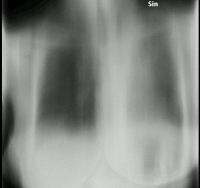
Photo from wikipedia
To the Editor: We found no published works reporting COVID-19 infection presenting as neutropenic fever in renal transplant adult patients. We report the first case. On March 18, 2020, a… Click to show full abstract
To the Editor: We found no published works reporting COVID-19 infection presenting as neutropenic fever in renal transplant adult patients. We report the first case. On March 18, 2020, a 33-year-old female presented to our hospital with chief complaint of dry cough and dyspnea for 5 days prior to admission that progressively gotten worse. She had fever (temperature of 38.3 C) and malaise. She had End Stage Renal Disease (ESRD) and had Living Unrelated Kidney Transplant in February of 2019. She travelled to Ghana for medical mission trip with layover in Paris on March 6th. Physical exam was remarkable for bilateral crackles in her lungs and labored respiration. Labs showed low white blood cell (absolute neutrophil count of 0.8 k/cumm). A nasopharyngeal/oropharyngeal swab specimen was obtained and sent for detection of COVID-19. Rapid flu A/B test and HIV-1/-2 Ab/HIV Ag QL were negative. CMV IgG EIA QN and EBV VCA IgM EIA were not checked during this admission. Computerized tomography scan of chest showed new patchy peripheral interstitial and airspace opacities with air bronchograms within both lungs. The PCR for COVID-19 came back positive (confirmed by COVID-19 GeneXpert detection) on March 19, 2020. The patient was initiated on Hydroxychloroquine 400 mg po twice a day for 1 day then 200 mg twice a day for total 5 days. Given her immunosuppressed status with COVID-19 associated with neutropenic fever, she was given Cefepime for 5 days and Azithromycin for 3 days. Home medications were continued including Fluticasone and Salmeterol Diskus, Ferrous Gluconate, Malarone (Atovaquone and Proguanil), Montelukast, Tacrolimus, Acetaminophen, Albuterol HFA, Ondansetron and Cetirizine. The patient was not on ACE inhibitor due to the fact she had history of angioedema. She was given IVF in the form of Sodium Chloride 0.9% at 100 mL/hour. Her Mycophenolic acid was stopped when her COVID-19 test came back positive and her Tacrolimus dose was adjusted to achieve a level of 3-5 ng/mL. Her creatinine, WBCs, platelets and hemoglobin dropped during her hospitalization (Figure 1). The patient improved and was discharged home on March 24, 2020. She was placed on self-quarantine till April 17, 2020. The patient's symptoms resolved on April 30, 2020 with both clinical and laboratorial improvement.
Journal Title: Reviews in Medical Virology
Year Published: 2020
Link to full text (if available)
Share on Social Media: Sign Up to like & get
recommendations!